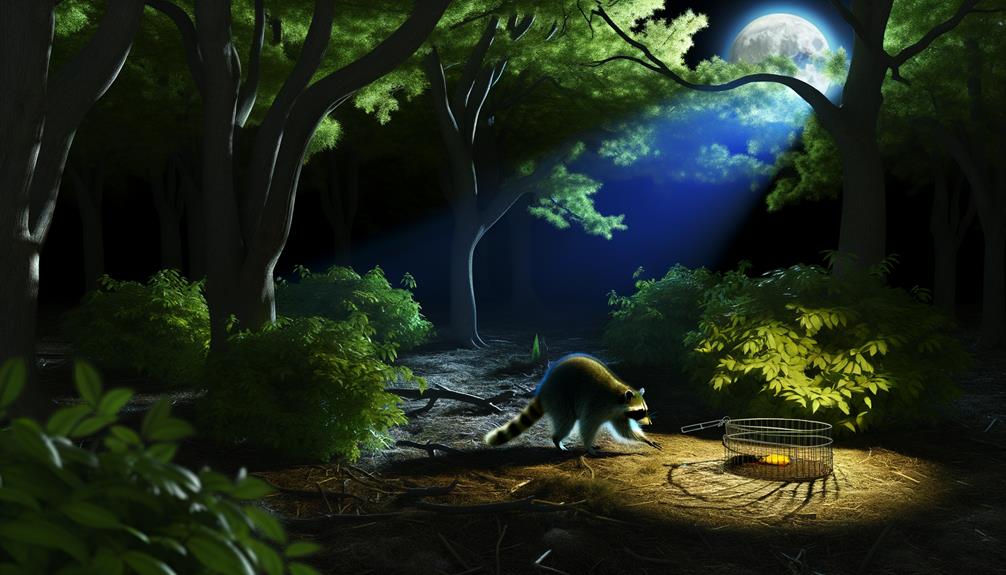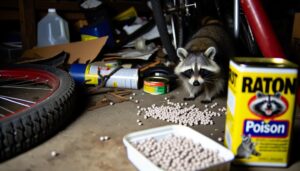Do Trap a Raccoon in 7 Simple Steps
Trapping a raccoon involves using a live catch trap placed near areas they frequent, such as garbage cans or gardens. Utilize bait reflecting their natural diet to increase success.
Always comply with local wildlife regulations, which may require permits or prohibit certain traps. Prioritize safety by wearing protective gear and handling the trap carefully.
Check the trap frequently, ensuring humane treatment and promptly releasing any non-target animals. Once captured, relocate the raccoon to a suitable habitat with natural resources, following all legal and safety guidelines.
To explore more about humane trapping techniques and legal requirements, continue on.

Key Takeaways
- Use live catch traps approved by local wildlife authorities.
- Place traps along raccoon travel paths or near food sources like garbage cans.
- Bait traps with foods raccoons naturally eat, such as fruits or fish.
- Check traps at least twice daily to ensure proper operation and humane treatment.
- Wear protective gear and follow local regulations when handling and releasing captured raccoons.
Understanding Raccoon Behavior
Understanding raccoon behavior is vital for safely and humanely trapping these intelligent and adaptable creatures. Raccoons are nocturnal, meaning they are most active during the night. They are attracted to food sources such as garbage, pet food, and garden crops. Their keen sense of smell and dexterous front paws enable them to access various food sources and shelter locations.
When planning to trap a raccoon, it is essential to place traps in areas where raccoons are frequently seen or where evidence of their activity, like tracks or droppings, is found. Using bait that mimics their natural diet can also increase trapping success. Ensuring the trap is stable and checking it frequently helps in minimizing stress and ensuring humane treatment of the animal.
Legal Considerations
When planning to trap a raccoon, it is vital to familiarize yourself with local wildlife regulations to guarantee compliance with legal requirements. Many regions have specific laws governing the capture and relocation of raccoons, including the necessity for permits or licenses.
Adhering to these regulations is essential to secure humane treatment and avoid legal repercussions. Additionally, some areas may prohibit the use of certain types of traps or mandate specific handling and release procedures.
Consulting with local wildlife authorities or a licensed pest control professional can provide valuable guidance. Remember, humane practices are paramount; use traps that minimize harm and stress to the animal, ensuring its safe and ethical treatment throughout the trapping process.
Choosing the Right Trap
Choosing the right trap is crucial to guaranteeing the humane and effective capture of a raccoon. Selecting a live catch trap, also known as a cage trap, is highly recommended. These traps are designed to capture the animal without causing injury.
The trap should be sturdy, with dimensions of at least 32 inches in length, 10 inches in width, and 12 inches in height to accommodate the raccoon's size comfortably. It's important to choose a trap with a sensitive trigger mechanism to ensure quick closure.
Additionally, opt for a model with a rear door for easy release, reducing stress on the animal. Always verify that the trap is approved by local wildlife authorities to comply with legal and ethical standards.
Safety Precautions
When trapping a raccoon, it is crucial to prioritize safety by wearing appropriate protective gear, handling the trap correctly to avoid injuries, and guaranteeing the humane release of the animal.
Always use thick gloves and long sleeves to prevent bites and scratches. Additionally, follow guidelines for setting and transporting the trap to minimize stress on the raccoon and secure a safe release back into its natural habitat.
Protective Gear Necessities
Ensuring your safety while attempting to trap a raccoon is paramount, requiring specific protective gear to minimize the risk of injury and disease transmission. Raccoons are known carriers of various diseases such as rabies and leptospirosis, necessitating stringent safety measures. Appropriate gear can mitigate these risks, ensuring a safer and more humane trapping process.
Essential items include:
- Heavy-duty gloves: These protect your hands from bites and scratches.
- Long-sleeved clothing: Provides a barrier against potential contact with fur and bodily fluids.
- Face shield or mask: Guards against respiratory exposure to pathogens.
- Sturdy boots: Prevent injuries from sharp objects and provide additional protection if the raccoon becomes aggressive.
Proper Trap Handling
Equipped with the appropriate protective gear, it is now essential to adhere to proper trap handling techniques to guarantee both your safety and the humane treatment of the raccoon.
First, make sure the trap is sturdy and functioning correctly before setting it. Always place the trap on a flat, stable surface to prevent tipping. Use gloves when handling the trap to avoid transferring human scent, which can deter raccoons. Check the trap frequently, ideally every few hours, to minimize the raccoon's stress.
When approaching a trapped raccoon, do so calmly and quietly to prevent startling it. Cover the trap with a cloth to reduce the animal's anxiety during transport. These practices not only ensure safety but also promote humane treatment.
Safe Release Practices
To safely release a trapped raccoon, prioritize both your safety and the animal's well-being by selecting an appropriate release location away from residential areas. Guarantee the environment is suitable for raccoons, providing ample food sources and natural shelter.
Follow these safety and humane practices:
- Wear protective gloves and clothing to prevent bites or scratches.
- Keep the trap covered with a cloth to minimize stress for the raccoon during transportation.
- Release during daylight hours when raccoons are less active and more likely to find immediate shelter.
- Open the trap carefully and stand back to give the raccoon space to exit calmly.
Placement of the Trap
Strategically positioning the trap is crucial for effectively and humanely capturing a raccoon. Place the trap along known raccoon pathways, typically identified by tracks, droppings, or signs of foraging. Ideal locations include near garbage cans, gardens, or entrances to attics and crawl spaces.
Make sure the trap is stable and level to prevent injury. Avoid placing the trap in direct sunlight or extreme weather conditions to provide a comfortable environment. Camouflage the trap with natural materials like leaves or branches to blend it into the surroundings without obstructing the entrance.
Always check local regulations and guidelines to ensure compliance with humane capture practices. Additionally, monitor the trap frequently to promptly address the captured raccoon's needs.
Selecting Effective Bait
Selecting the right bait is essential for successfully trapping a raccoon and ensuring a safe, humane capture. Popular bait options include marshmallows, canned tuna, and fruit, which are particularly effective given a raccoon's varied diet.
Careful bait placement near the trap's trigger mechanism increases the likelihood of a swift, efficient capture while minimizing stress to the animal.
Popular Bait Options
Choosing the right bait can greatly enhance the effectiveness and humaneness of your raccoon trapping efforts. Selecting bait that is highly appealing to raccoons while ensuring minimal attraction to non-target species is essential.
The following bait options have proven to be both effective and safe:
- Marshmallows: Their sweetness and bright color attract raccoons while being less appealing to other wildlife.
- Canned Cat Food: Its strong odor is a powerful attractant for raccoons, especially when fish-flavored.
- Fruits: Grapes and apples are enticing due to their natural sugars and aroma.
- Peanut Butter: Its rich scent and taste make it a reliable choice, easily spread on various surfaces within the trap.
Employing these baits enhances trap success while prioritizing humane and ethical practices.
Bait Placement Tips
Proper bait placement is vital for maximizing the effectiveness and humaneness of your raccoon trapping efforts. Position the bait at the rear of the trap, making sure that the raccoon must fully enter the trap to reach it. This technique reduces the likelihood of the animal triggering the trap prematurely and escaping.
Use a small amount of bait to prevent easy access from outside the trap. Securely attach or place the bait in a container to make it more enticing and prevent it from being easily removed.
When setting the trap, consider the natural foraging behavior of raccoons by placing it along known travel paths or near food sources. This strategic placement enhances both efficiency and humane capture.
Setting the Trap
To set the trap effectively and humanely, place it in an area where raccoon activity is frequently observed, making sure it is stable and secure. Positioning the trap correctly increases the likelihood of capturing the raccoon without causing harm. Additionally, consider the following points to optimize effectiveness:
- Location: Choose a flat surface away from direct sunlight or heavy foot traffic.
- Concealment: Use natural materials like leaves or branches to blend the trap into its surroundings.
- Stability: Secure the trap to prevent tipping or movement that could injure the raccoon.
- Weather Protection: Shield the trap from rain or extreme weather conditions to maintain its functionality and bait attractiveness.
These practices guarantee a humane and successful trapping process while prioritizing safety and ethical considerations.
Monitoring the Trap
Observing the trap is vital to guarantee the humane and safe capture of the raccoon.
It is essential to check the trap regularly, ideally every few hours, to minimize stress on the animal.
Additionally, implementing proper safety precautions will protect both the individual handling the trap and the raccoon itself.
Checking Trap Regularly
Regular inspections of the trap are vital to safeguard the well-being of the captured raccoon and to adhere to humane trapping practices. Monitoring the trap regularly guarantees that the raccoon does not experience stress, exposure, or dehydration. Additionally, it helps in preventing unintended captures or potential harm to non-target animals.
Here are some key points to keep in mind:
- Check the trap at least twice daily, preferably in the early morning and late evening.
- Verify the trap is operational and that the bait remains enticing to raccoons.
- Provide water and shade if the trap is in a sunny or exposed area.
- Promptly release non-target animals to prevent unnecessary stress or injury.
Following these guidelines promotes responsible and humane trapping.
Safety Precautions
Securing safety while monitoring the trap is crucial to protect both the raccoon and the individual handling the trap. Regularly inspect the trap at least twice a day to prevent prolonged distress or injury to the captured animal.
Maintain a safe distance when approaching the trap, and wear gloves to minimize the risk of bites or scratches. Never place your fingers near the trap's openings. Utilize a sturdy, long-handled tool to gently lift the trap cover, avoiding direct contact.
If the raccoon appears distressed or aggressive, contact a wildlife professional for assistance. Always follow local wildlife regulations and humane practices to guarantee the raccoon is relocated safely and ethically.
Handling a Captured Raccoon
Upon successfully capturing a raccoon, it is important to prioritize both your safety and the animal's welfare during handling. Promoting a humane and safe approach involves several key steps:
- Wear Protective Gear: Always use thick gloves and long sleeves to prevent bites and scratches.
- Minimize Stress: Keep the trap covered with a cloth to reduce the raccoon's stress levels.
- Avoid Direct Contact: Never attempt to touch or handle the raccoon directly; use tools designed for animal handling.
- Check Local Regulations: Confirm compliance with local wildlife laws regarding the handling of captured animals.
Relocating the Raccoon
When relocating the raccoon, it is crucial to choose a suitable release site that adheres to local regulations and guarantees the animal's safety and well-being. Make sure the area is away from urban settings to prevent further human-wildlife conflicts. The site should provide natural resources such as food, water, and shelter to support the raccoon's survival.
| Criteria | Description | Importance |
|---|---|---|
| Location | Away from urban areas | Prevents future conflicts |
| Food Source | Availability of natural food sources | Ensures sustenance |
| Water Availability | Access to clean water | Essential for hydration |
| Shelter | Presence of natural shelters like trees or burrows | Provides safety |
| Legal Compliance | Adheres to local wildlife laws | Avoids legal issues |
These considerations help guarantee a humane and responsible relocation process.
Cleaning and Sanitizing
Proper cleaning and sanitizing of the area where the raccoon was trapped are crucial to prevent the spread of diseases and maintain a safe environment. Raccoons can carry pathogens such as leptospirosis, raccoon roundworm, and rabies.
To guarantee thorough sanitation, follow these expert guidelines:
- Wear protective gear: Utilize gloves and a face mask to shield yourself from potential contaminants.
- Disinfect surfaces: Clean all surfaces with a bleach solution (one part bleach to nine parts water) to eradicate harmful bacteria and viruses.
- Dispose of waste properly: Seal and dispose of any contaminated materials, such as bedding or feces, in a secure trash receptacle.
- Ventilate the area: Ensure proper airflow to diminish the concentration of airborne pathogens.
Adhering to these steps ensures a safe and compassionate process.
Preventing Future Issues
To prevent future raccoon intrusions, it is essential to identify and seal potential entry points in your home or property. Begin by inspecting areas such as roof vents, chimneys, and gaps around windows and doors. Use heavy-gauge mesh or metal flashing to cover these openings securely.
Make sure garbage cans are tightly sealed and stored in a secure location, as raccoons are attracted to food waste. Trim tree branches that overhang your roof to eliminate easy access routes. Implement motion-activated lights or sprinklers to deter raccoons from approaching.
Conclusion
To summarize, understanding raccoon behavior, adhering to legal regulations, and choosing the appropriate trap are essential for safely and humanely capturing these cunning creatures.
Proper placement and handling of the trap, combined with meticulous relocation and sanitization procedures, are paramount. Employing these expert methods will transform any raccoon invasion into a distant memory, ensuring peace and safety for both humans and raccoons alike.
Preventative measures will further safeguard against future encounters, creating an impregnable fortress against these nocturnal invaders.






